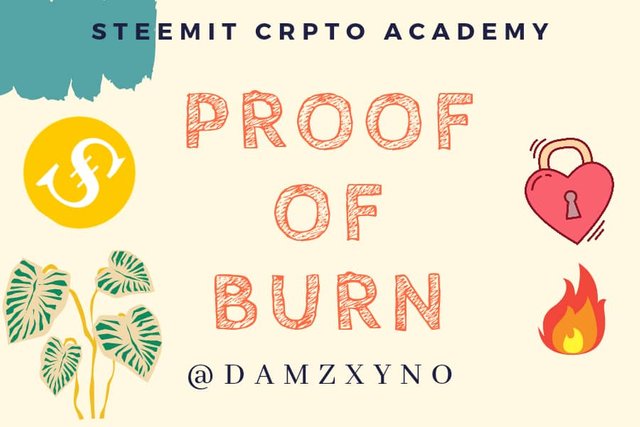
Good day everyone, this is my solution to professor
@alphafx's homework.
Consensus Algorithm:
It is also known as consensus mechanism. Consensus mechanism is adopted by a blockchain network in order to come to an agreement and determine the state of the blockchain, answering questions such as the validity of the blockchain network, block addition, when to add block and who to add the block. Consensus implementation differ based on decentralization, security, incentives among other measures. There are a lot of consensus mechanism which includes but not limited to proof of work, proof of state, delegated proof of state, proud of authority, proof of importance, proof of capacity, proof of weight, proof of believability and proof of contribution. The most common include proof of work, proof of stake and delegated proof of stake. In this assignment, I'll be discussing extensively on proof of burn.
Proof of Burn
It is a consensus mechanism that help to secure and ensure the validity of a blockchain by burning coins, it's an alternative to previously existing consensus mechanism such as Proof of Work and Proof of stake. To understand fully what Proof of Burn is, one need to understand Proof of Work. This is because proof of work is similar to proof of work with the exception that proof of burn is more efficient- there is little power consumption and there is no need for powerful hardware investments by miners.
Quickly, on Proof of Work: It is the first consensus mechanism which was implemented by the bitcoin blockchain. Different nodes races to solve a cryptograhic problem and whosoever solves the cryptograhic problem first is granted the right to add the next block. Though it is hard to solve, it is easy to check. This consensus mechanism is very secure but takes a lot of time and requires sophisticated hardwares and powerful computational resources. This is the problem Proof of Burn solves.
Consensus Mechanism: Proof of Work
Invention:
Different versions of proof of burn exists but the first and most common version was invented by Iain Stewart. He describe the protocol with an analogy of a mining rig where miners burn their coins inorder to acquire a virtual mining rig. The acquired mining rig size is dependent on the total amount of coin burnt. The rig then grants the miner the power to mine blocks on the blockchain.
Principle:
Miners burn cryptocurrency coins, this grants them the right to mine/produce blocks on the blockchain, the block produced is in the proportion of coin burnt. The concept of burning coins in proof of burn is explained as taking a specific portion of a coin in circulation to be sent to a wallet nobody has access to.
The inaccessible wallet:
When coins are burnt, they are sent to a randomly generated wallet address which has no a private key, hence they can not be accessed by anyone. These coin have been pulled out of circulation. This can have a tremendous effect on the increase in value of the coin.
Mining Power:
Mining of new blocks is achieved with the use of mining power. This mining power is acquired by burning token, however, this is not a one time investments as mining power reduces as new blocks are being mined (created). This reduction of mining power as a result of mining blocks is referred to as decay. This is a mechanism put in place which promotes constant burning of cryptocurrency coins by miners in order to maintain their mining power.
Effects of burning activities:
Burning activities strengthens the networks while miners are rewarded for their activities . These activities. constantly ongoing as miners can mine on top of each other's block and add the transactions of other miners to their block.
Advantages of Proof of Burn (PoB):
Compared to other consensus mechanisms, proof of burn consumes less energy and produces a result in lesser time. There is no need for the use of powerful hardware or powerful computational resources. There is reduction in problems like artificial price swings which is caused by investments in mining hardwares or influence of multipools. Proof of burn can also be used for bootstrapping one cryptocurrency off of another cryptocurrency.
Disadvantages of Proof of Burn:
It is very unpopular compared to proof of stake and proof of work consensus mechanism. Even the popular Slimcoin which uses proof of burn mechanism implements proof of work and proof of stake along with it package.
In conclusion:
Proof of Burn mechanism is highly efficient as it consumes less energy compared to the proof of work. It prevents accumulation of unnecessary power as miners have their mining power decay with each block mined, hence no unfair advantage is given to anyone. However, in the coming years, there is a high chance many blockchain will adopt the mechanism.
This is a link to my Twitter post:
https://twitter.com/Damzxyno/status/1391809865102802957?s=19
Excellent work, very organised. Good job
Thanks for participating